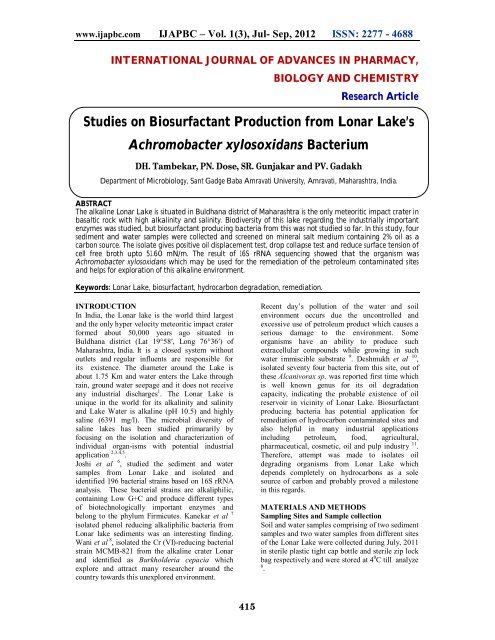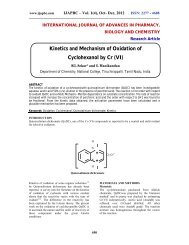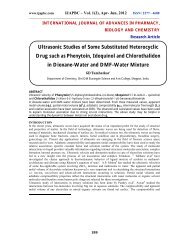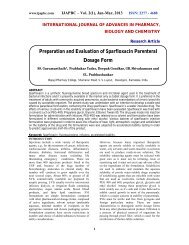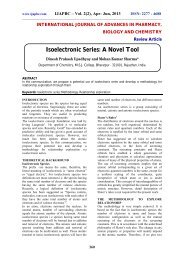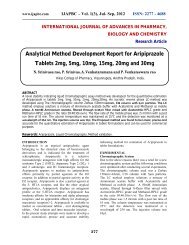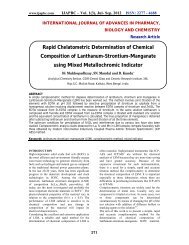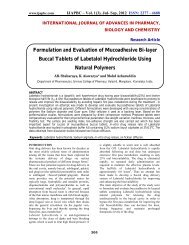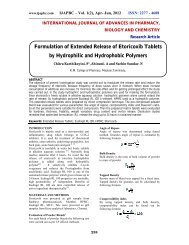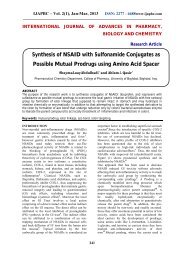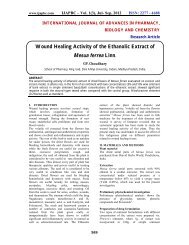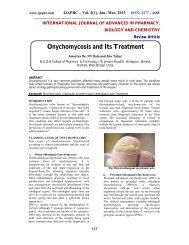Studies on Biosurfactant Production from Lonar Lake's ... - ijapbc
Studies on Biosurfactant Production from Lonar Lake's ... - ijapbc
Studies on Biosurfactant Production from Lonar Lake's ... - ijapbc
You also want an ePaper? Increase the reach of your titles
YUMPU automatically turns print PDFs into web optimized ePapers that Google loves.
www.<strong>ijapbc</strong>.com IJAPBC – Vol. 1(3), Jul- Sep, 2012 ISSN: 2277 - 4688<br />
INTERNATIONAL JOURNAL OF ADVANCES IN PHARMACY,<br />
BIOLOGY AND CHEMISTRY<br />
Research Article<br />
<str<strong>on</strong>g>Studies</str<strong>on</strong>g> <strong>on</strong> <strong>Biosurfactant</strong> Producti<strong>on</strong> <strong>from</strong> L<strong>on</strong>ar Lake’s<br />
Achromobacter xylosoxidans Bacterium<br />
DH. Tambekar, PN. Dose, SR. Gunjakar and PV. Gadakh<br />
Department of Microbiology, Sant Gadge Baba Amravati University, Amravati, Maharashtra, India.<br />
ABSTRACT<br />
The alkaline L<strong>on</strong>ar Lake is situated in Buldhana district of Maharashtra is the <strong>on</strong>ly meteoritic impact crater in<br />
basaltic rock with high alkalinity and salinity. Biodiversity of this lake regarding the industrially important<br />
enzymes was studied, but biosurfactant producing bacteria <strong>from</strong> this was not studied so far. In this study, four<br />
sediment and water samples were collected and screened <strong>on</strong> mineral salt medium c<strong>on</strong>taining 2% oil as a<br />
carb<strong>on</strong> source. The isolate gives positive oil displacement test, drop collapse test and reduce surface tensi<strong>on</strong> of<br />
cell free broth upto 51.60 mN/m. The result of 16S rRNA sequencing showed that the organism was<br />
Achromobacter xylosoxidans which may be used for the remediati<strong>on</strong> of the petroleum c<strong>on</strong>taminated sites<br />
and helps for explorati<strong>on</strong> of this alkaline envir<strong>on</strong>ment.<br />
Keywords: L<strong>on</strong>ar Lake, biosurfactant, hydrocarb<strong>on</strong> degradati<strong>on</strong>, remediati<strong>on</strong>.<br />
INTRODUCTION<br />
In India, the L<strong>on</strong>ar lake is the world third largest<br />
and the <strong>on</strong>ly hyper velocity meteoritic impact crater<br />
formed about 50,000 years ago situated in<br />
Buldhana district (Lat 19°58′, L<strong>on</strong>g 76°36′) of<br />
Maharashtra, India. It is a closed system without<br />
outlets and regular influents are resp<strong>on</strong>sible for<br />
its existence. The diameter around the Lake is<br />
about 1.75 Km and water enters the Lake through<br />
rain, ground water seepage and it does not receive<br />
any industrial discharges 1 . The L<strong>on</strong>ar Lake is<br />
unique in the world for its alkalinity and salinity<br />
and Lake Water is alkaline (pH 10.5) and highly<br />
saline (6391 mg/l). The microbial diversity of<br />
saline lakes has been studied primararily by<br />
focusing <strong>on</strong> the isolati<strong>on</strong> and characterizati<strong>on</strong> of<br />
individual organ-isms with potential industrial<br />
applicati<strong>on</strong> 2,3,4,5 .<br />
Joshi et al 6 , studied the sediment and water<br />
samples <strong>from</strong> L<strong>on</strong>ar Lake and isolated and<br />
identified 196 bacterial strains based <strong>on</strong> 16S rRNA<br />
analysis. These bacterial strains are alkaliphilic,<br />
c<strong>on</strong>taining Low G+C and produce different types<br />
of biotechnologically important enzymes and<br />
bel<strong>on</strong>g to the phylum Firmicutes. Kanekar et al 7<br />
isolated phenol reducing alkaliphilic bacteria <strong>from</strong><br />
L<strong>on</strong>ar lake sediments was an interesting finding.<br />
Wani et al 8 , isolated the Cr (VI)-reducing bacterial<br />
strain MCMB-821 <strong>from</strong> the alkaline crater L<strong>on</strong>ar<br />
and identified as Burkholderia cepacia which<br />
explore and attract many researcher around the<br />
country towards this unexplored envir<strong>on</strong>ment.<br />
Recent day’s polluti<strong>on</strong> of the water and soil<br />
envir<strong>on</strong>ment occurs due the unc<strong>on</strong>trolled and<br />
excessive use of petroleum product which causes a<br />
serious damage to the envir<strong>on</strong>ment. Some<br />
organisms have an ability to produce such<br />
extracellular compounds while growing in such<br />
water immiscible substrate 9 . Deshmukh et al 10 ,<br />
isolated seventy four bacteria <strong>from</strong> this site, out of<br />
these Alcanivorax sp. was reported first time which<br />
is well known genus for its oil degradati<strong>on</strong><br />
capacity, indicating the probable existence of oil<br />
reservoir in vicinity of L<strong>on</strong>ar Lake. <strong>Biosurfactant</strong><br />
producing bacteria has potential applicati<strong>on</strong> for<br />
remediati<strong>on</strong> of hydrocarb<strong>on</strong> c<strong>on</strong>taminated sites and<br />
also helpful in many industrial applicati<strong>on</strong>s<br />
including petroleum, food, agricultural,<br />
pharmaceutical, cosmetic, oil and pulp industry 11 .<br />
Therefore, attempt was made to isolates oil<br />
degrading organisms <strong>from</strong> L<strong>on</strong>ar Lake which<br />
depends completely <strong>on</strong> hydrocarb<strong>on</strong>s as a sole<br />
source of carb<strong>on</strong> and probably proved a milest<strong>on</strong>e<br />
in this regards.<br />
MATERIALS AND METHODS<br />
Sampling Sites and Sample collecti<strong>on</strong><br />
Soil and water samples comprising of two sediment<br />
samples and two water samples <strong>from</strong> different sites<br />
of the L<strong>on</strong>ar Lake were collected during July, 2011<br />
in sterile plastic tight cap bottle and sterile zip lock<br />
bag respectively and were stored at 4 0 C till analyze<br />
6 .<br />
415
www.<strong>ijapbc</strong>.com IJAPBC – Vol. 1(3), Jul- Sep, 2012 ISSN: 2277 - 4688<br />
Enrichment of samples<br />
Soil (1g) and water (10ml) samples <strong>from</strong> L<strong>on</strong>ar<br />
Lake were separately inoculated in 250ml c<strong>on</strong>ical<br />
flask c<strong>on</strong>taining 100ml mineral salt medium having<br />
compositi<strong>on</strong> (g/l):NaNO 3 2.5g; KCl 0.1g; KH 2 PO 4<br />
3.0g; K 2 HPO 4 7.0g; CaCl 2 0.01g; MgSO 4 .7H 2 O<br />
0.5g and 5ml of trace element soluti<strong>on</strong> c<strong>on</strong>tains:<br />
FeSO 4 .7H 2 O 0.116g/l; H 3 BO 3 0.232g/l;<br />
CoCl 2 .6H 2 O 0.41g/l; CuSO 4 .5H 2 O 0.008g/l;<br />
MnSO 4 .H 2 O 0.008g/l; [NH 4 ] 6 Mo 7 O 24 0.022g/l;<br />
ZnSO 4 0.174g/l with 2% soybean oil as a sole<br />
source of carb<strong>on</strong> and were incubated at 37 0 C at<br />
200rpm <strong>on</strong> rotary shaker for 7days and same<br />
procedure was successively repeated for<br />
enrichment.<br />
Isolati<strong>on</strong> and biochemical characterizati<strong>on</strong><br />
After enrichment the samples were inoculated <strong>on</strong><br />
solid nutrient agar plate and well isolated and<br />
morphologically different col<strong>on</strong>ies were selected<br />
and stock culture were prepared and stored at 4 0 C.<br />
All these isolates were further characterized by<br />
standard biochemical test according to Bergey’s<br />
manual of systematic bacteriology.<br />
Preliminary screening for biosurfactant<br />
producti<strong>on</strong><br />
Biochemically characterized isolates were cultured<br />
in mineral salt medium and incubated at 37 0 C for<br />
7days at 200rpm <strong>on</strong> rotary shaker. After incubati<strong>on</strong><br />
broth was centrifuged at 8000rpm for 20min oil<br />
layer was discarded and supernatant were<br />
subsequently subjected for the preliminary<br />
screening.<br />
Surface tensi<strong>on</strong> measurements<br />
Surface tensi<strong>on</strong> reducti<strong>on</strong> was measured using<br />
Krüss Hamburg Nr2215 Tensiometer by<br />
submerging the platinum ring in culture<br />
supernatant and the force required to pull it through<br />
the air–liquid interface was recorded. The results<br />
were compared to distilled water and medium<br />
compositi<strong>on</strong> as negative c<strong>on</strong>trol 12 .<br />
Oil spreading method<br />
Fifty milliliter of distilled water added to the<br />
petridish followed by additi<strong>on</strong> of 20µl of soybean<br />
oil, thin layer was allowed to form <strong>on</strong> water<br />
surface. Then 10µl of cell free supernatant was<br />
dropped <strong>on</strong> oil surface. The diameter of z<strong>on</strong>e of<br />
clearing of oil surface was measured 12 .<br />
Drop collapse method<br />
A modified drop collapse method was performed<br />
by using 96 well micro titer- plates c<strong>on</strong>taining 10µl<br />
soybean oil was equilibrated for an hour at room<br />
temperature. Then 10µl of culture supernatant was<br />
added to the surface of well and observed after 1<br />
minute for collapsing of drop. Drop collapse test<br />
was c<strong>on</strong>sidered positive when the drop diameter<br />
more than those produced by distilled water.<br />
Emulsificati<strong>on</strong> index (E 24 )<br />
E 24 of samples was determined by adding 2ml of<br />
soybean oil to 3ml of culture supernatant and<br />
vortex for 2 min with high speed and leave to stand<br />
for 24 hours. The E 24 index is given as percentage<br />
of height of emulsified layer (mm) divided by total<br />
height of the liquid column (mm) 13 .<br />
E 24 =<br />
Height of emulsi<strong>on</strong> layer<br />
Height of total soluti<strong>on</strong><br />
X 100%<br />
Identificati<strong>on</strong> of bacteria <strong>on</strong> the basis of 16S<br />
rRNA sequencing<br />
The culture showing biosurfactant producti<strong>on</strong> was<br />
further submitted to NCCS, Pune for 16S rRNA<br />
sequencing. The resulting sequences were<br />
compared with sequences in the Gene bank<br />
database of NCBI 14 using the BLAST network<br />
service. Sequences obtained were submitted to<br />
RDP and match with known sequence.<br />
Methods for estimati<strong>on</strong> of residual oil<br />
The method for estimating of residual oil in liquid<br />
broth was different <strong>from</strong> that for solid stuffing. The<br />
residual oil in broth was extracted with petroleum<br />
ether. For extracti<strong>on</strong> of residual oil 10ml petroleum<br />
ether was added in the flask, after vigorous shaking<br />
flask were allowed to stand for 10min and organic<br />
layer was collected by separating funnel. Oil layer<br />
c<strong>on</strong>taining petroleum ether was evaporated <strong>on</strong> sand<br />
bath and gravimetric estimati<strong>on</strong> was made by<br />
weighing the quantity of oil in the beaker 15, 16 .<br />
RESULTS AND DISCUSSION<br />
While studying the biosurfactant producing<br />
bacteria <strong>from</strong> alkaline L<strong>on</strong>ar Lake, a total of four<br />
samples comprising of sediment and water samples<br />
during rainy seas<strong>on</strong> 2011 were collected and<br />
processed strictly <strong>on</strong> oil c<strong>on</strong>taining media. After<br />
sub-culturing for 4-5 times bacteria were isolated<br />
<strong>on</strong> solid nutrient agar plate. The bacteria were<br />
analyzed for standard biochemical test and further<br />
identified by 16S rRNA sequencing as<br />
Achromobacter xylosoxidans.<br />
416
www.<strong>ijapbc</strong>.com IJAPBC – Vol. 1(3), Jul- Sep, 2012 ISSN: 2277 - 4688<br />
Table 1: Morphology and biochemical characteristic of bacteria<br />
Test Result Test Result Test Result<br />
Col<strong>on</strong>y shape Circular VP test Negative Celloboise Negative<br />
Colour White Citrate Utilizati<strong>on</strong> positive Sorbitol Negative<br />
Gram staining Negative Maltose Negative Trehalose Positive<br />
Shape Short rod Lactose Negative Salicin Negative<br />
Arrangement Single Dextrose Positive Sucrose Negative<br />
Urease Negative Mannitol Negative Fructose Negative<br />
Starch hydrolysis Negative Xylose Negative Growth at 4 0 C Negative<br />
Indole Negative Arabinose Negative At 42 0 C Positive<br />
Methyl red Negative Raffinose Negative At 6.5% NaCl Positive<br />
Bacteria <strong>on</strong> the basis of 16S rRNA : Achromobacter xylosoxidans subsp. xylosoxidans; CBMAI<br />
709<br />
All selected isolates were gram negative short rod,<br />
aerobic and motile and ferment <strong>on</strong>ly dextrose and<br />
trehalose with acid producti<strong>on</strong> and utilized citrate<br />
(Table 1).<br />
The isolates when studied for the biosurfactant<br />
producti<strong>on</strong> gives positive drop collapse test, oil<br />
displacement test and emulsify the oil layer upto<br />
58%. Tambekar et al, 17 2012 also isolated the<br />
biosurfactant producing bacteria <strong>from</strong> petroleum<br />
c<strong>on</strong>taminated soil, and reported Pseudom<strong>on</strong>as<br />
aeruginosa isolate emulsify the oil layer upto<br />
57.14% and reduces the surface tensi<strong>on</strong> of broth<br />
upto 47.19mN/m whereas, Achromobacter<br />
xylosoxidans isolated <strong>from</strong> L<strong>on</strong>ar Lake reduced the<br />
surface tensi<strong>on</strong> of culture supernatant upto 51.60<br />
mN/m after 3days of incubati<strong>on</strong> which was initially<br />
64.65 mN/m and c<strong>on</strong>firm the biosurfactant<br />
producti<strong>on</strong> (Table 2).<br />
GTCACTTCACGCGTTAGCTGCGCTACCAAGGCCCGAAGGCCCCAACAGCTAGTTGACATCGTTTAGGGCGTGGACTACCA<br />
GGGTATCTAATCCTGTTTGCTCCCCACGCTTTCGTGCATGAGCGTCAGTGTTATCCCAGGAGGCTGCCTTCGCCATCGGTG<br />
TTCCTCCGCATATCTACTCATTTCACTGCTACACGCGGAATTCCACCTCCCTCTGACACAC<br />
Achromobacter xylosoxidans strain CBMAI 709 16S ribosomal RNA gene,<br />
Lineage:<br />
Results for Query Sequence: seqmatch_seq, 212 unique oligos<br />
norank Root (10) (match sequences)<br />
domain Bacteria (10)<br />
phylum "Proteobacteria" (10)<br />
class Betaproteobacteria (10)<br />
order Burkholderiales (10)<br />
family Alcaligenaceae (10)<br />
genus Achromobacter (10)<br />
S000000970 - not calculated 0.953 1381 Alcaligenes sp.; 159; AJ002804<br />
S000012321 - not calculated 0.953 1393 Alcaligenes sp.; 151; AJ002802<br />
S000106588 - not_calculated 0.953 1405 Achromobacter xylosoxidans subsp. xylosoxidans; F; AJ491845<br />
S000107277 - not_calculated 0.953 1405 Achromobacter xylosoxidans subsp. xylosoxidans; A1; AJ491839<br />
S000108346 - not_calculated 0.953 1397 Achromobacter xylosoxidans subsp. xylosoxidans; E; AJ491844<br />
S000118379 - not_calculated 0.953 1402 Alcaligenes faecalis subsp. faecalis; 6818m-E; AJ508999<br />
S000354949 -not_calculated 0.958 1407 uncultured bacterium; KRA30+05; AY081976<br />
S000824400 -not_calculated 0.967 1151 Achromobacter xylosoxidans subsp. xylosoxidans; CBMAI 709; DQ413030<br />
S001600795 - not_calculated 0.967 1362 uncultured Achromobacter sp.; F1 jan. 7; GQ416668<br />
S001744292 - not calculated 0.958 1326 [Streptomyces] sp. SDAP 101; GQ408915<br />
After the c<strong>on</strong>firmati<strong>on</strong> of biosurfactant producti<strong>on</strong><br />
isolates BW1 was further studied for the<br />
hydrocarb<strong>on</strong> degradati<strong>on</strong> potential by petroleum<br />
ether estimati<strong>on</strong> method 15, 16 .<br />
Table 2: properties of selected biosurfactant<br />
producing bacteria<br />
ST of<br />
Drop Oil<br />
ST of<br />
Emulsificati<strong>on</strong><br />
media<br />
Isolate Collapse spreading<br />
supernatant<br />
Index test<br />
with oil<br />
test Test<br />
(mN/m)<br />
(mN/m)<br />
BW1 + + 58% 51.60 64.65<br />
417
www.<strong>ijapbc</strong>.com IJAPBC – Vol. 1(3), Jul- Sep, 2012 ISSN: 2277 - 4688<br />
Hydrocarb<strong>on</strong> degradati<strong>on</strong> potential of the isolate<br />
shows the percent degradati<strong>on</strong> of about 14.46% for<br />
first 24h incubati<strong>on</strong> but as incubati<strong>on</strong> period<br />
increases the percent degradati<strong>on</strong> increases upto<br />
25% but rate of degradati<strong>on</strong> of the hydrocarb<strong>on</strong><br />
decreases as the incubati<strong>on</strong> period increases i.e.<br />
percent degradati<strong>on</strong> rate is inversely proporti<strong>on</strong>al to<br />
the rate of degradati<strong>on</strong> (Fig. 1 and 2)). Although,<br />
the largest applicati<strong>on</strong> of biosurfactant is the oil<br />
industry, for petroleum producti<strong>on</strong> and<br />
incorporati<strong>on</strong> into oil formulati<strong>on</strong>s, oil spill<br />
bioremediati<strong>on</strong>, removal of oil sludge <strong>from</strong> storage<br />
tanks and enhanced oil recovery 18 (Desai and<br />
Banat, 1997) selected isolates will be used for the<br />
bioremediati<strong>on</strong> of the petroleum c<strong>on</strong>taminated site<br />
as the organism has oil degradati<strong>on</strong> capacity.<br />
In the present study, the potential of the<br />
Achromobacter xylosoxidans to produce the<br />
biosurfactant <strong>from</strong> the alkaline L<strong>on</strong>ar Lake is<br />
indicative of the treasure of the diverse industrially<br />
important microorganism which may be exploited<br />
further for commercial point of view. This study<br />
suggests that the L<strong>on</strong>ar Lake is the extreme<br />
envir<strong>on</strong>ment or system for the growth of organism.<br />
<strong>Biosurfactant</strong> obtained <strong>from</strong> organisms isolated<br />
<strong>from</strong> such envir<strong>on</strong>ment might be useful in extreme<br />
envir<strong>on</strong>ments such as temperate marine<br />
compartments and industrial systems where<br />
extremes of temperature are integral elements.<br />
60<br />
Fig. 1: Rate of degradati<strong>on</strong> (mg/ml) of oil<br />
30<br />
Fig. 2: Percent degradati<strong>on</strong> of oil<br />
Rate of degradati<strong>on</strong><br />
50<br />
40<br />
30<br />
20<br />
10<br />
0<br />
56.66<br />
24.79<br />
Rate of degradati<strong>on</strong><br />
(mg/ml)<br />
16.38<br />
11.87<br />
24h 48h 72h 96h<br />
Hour of incubati<strong>on</strong><br />
% degradati<strong>on</strong><br />
25<br />
20<br />
15<br />
10<br />
28.3<br />
25.15<br />
25.79<br />
% Degradati<strong>on</strong><br />
14.46<br />
24h 48h 72h 96h<br />
hour of incubati<strong>on</strong><br />
C<strong>on</strong>clusively, this study has shown that<br />
Achromobacter xylosoxidans, an organism isolated<br />
<strong>from</strong> L<strong>on</strong>ar Lake has ability to survive <strong>on</strong> such<br />
harsh envir<strong>on</strong>ment and also has degradative<br />
potential for oil. Because of the substrate diversity<br />
of this organism it is adjudged as a good candidate<br />
for bioremediati<strong>on</strong> of polluted sites and a potential<br />
resource for surface- active molecules of industrial<br />
importance.<br />
REFERENCES<br />
1. Thakker CD and Ranade DR .<br />
Alkalophilic Methanosarcina isolated<br />
<strong>from</strong> L<strong>on</strong>ar Lake. Curr Sci. 2002; 82:455-<br />
458.<br />
2. J<strong>on</strong>es BE, Grant WD, Duckworth AW and<br />
Owens<strong>on</strong> GG. Microbial diversity of soda<br />
lakes. Extremophiles. 1998;2:191-20<br />
3. Horikoshi K . Alkaliphiles: Some<br />
applicati<strong>on</strong>s of their products for<br />
biotechnology. Microbiol Mol Biol Rev.<br />
1999;63:735-750.<br />
4. Joshi AA, Kanekar PP, Sarnaik S and<br />
Kelkar A. Bacterial diversity of L<strong>on</strong>ar<br />
lake ecosystem. In: Banker SK, Mishra<br />
VR (Eds) Biodiversity of L<strong>on</strong>ar crater.<br />
Anamaya, New Delhi, 2005;71-75.<br />
5. Tambekar DH, Pawar AL and Dudhane<br />
MN . L<strong>on</strong>ar lake water: Past and present.<br />
Nature Envir<strong>on</strong> and Poll Technol. 2010;<br />
9(2):217-221.<br />
6. Joshi AA, Kanekar PP, Kelkar AS,<br />
Shouche YS, Vani AA, Borgave SB and<br />
Sarnaik SS. Cultivable bacterial diversity<br />
of alkaline L<strong>on</strong>ar Lake India. Microbiol<br />
Ecol. 2007;55(2):163-172.<br />
7. Kanekar PP, Sarnaik SS and Kelkar AS<br />
Bioremediati<strong>on</strong> of phenol by alkaliphilic<br />
bacteria isolated <strong>from</strong> alkaline Lake of<br />
L<strong>on</strong>ar, India. J Appl Microbiol (Suppl).<br />
1999;85:1285-1335.<br />
8. Wani R, Kodam KM, Gawai KR and<br />
Dhakephalkar PK. Chromate reducti<strong>on</strong> by<br />
Burkholderia cepacia MCMB-821,<br />
isolated <strong>from</strong> the pristine habitat of<br />
alkaline Crater Lake. Appl Microbiol<br />
Biotechnol. 2007;5:627–632; DOI<br />
10.1007/s00253-007-0862-77.<br />
9. Biria D, Magsoudi E, Roostaazad R,<br />
Dadafania H, Lofti A and Amoozegar<br />
MA. Purificati<strong>on</strong> and characterizati<strong>on</strong> of<br />
novel biosurfactant produced by<br />
Bacillus licheniformis MS3.world J<br />
Microbiol Biotechnol. 2010;26:871-878.<br />
418
www.<strong>ijapbc</strong>.com IJAPBC – Vol. 1(3), Jul- Sep, 2012 ISSN: 2277 - 4688<br />
10. Deshmukh KB, Pathak AP and Karuppayil<br />
MS. Bacterial Diversity of L<strong>on</strong>ar Soda<br />
Lake of India. Ind J Microbiol.<br />
2011;51(1):107-111 DOI 10.1007/s12088-<br />
011-0159-<br />
11. Brown MJ . <strong>Biosurfactant</strong>s for cosmetic<br />
applicati<strong>on</strong>. Int J Cosmet Sci. 1991;13:61-<br />
64<br />
12. Soudi MR, Nasr S, Mehrnia MR and<br />
Sarrafzadeh MH . Characterizati<strong>on</strong> of<br />
novel biosurfactant producing strains of<br />
Bacillus spp. isolated <strong>from</strong> petroleum<br />
c<strong>on</strong>taminated soil. Iran J Microbiol.<br />
2009;1(2):54-61.<br />
13. Abouseouda M, Maachi R and Amrane A.<br />
<strong>Biosurfactant</strong> producti<strong>on</strong> <strong>from</strong> olive oil by<br />
Pseudom<strong>on</strong>as<br />
Fluorescens.<br />
Communicating Curr Res Edu Topics<br />
Trends Appl Microbiol. 2007;340-347.<br />
14. http://www.ncbi.nlm.nih.gov<br />
15. Lu Yi-t<strong>on</strong>g, Chen Xiao-bin, Zhou Pei and<br />
Li Zhen-h<strong>on</strong>g . Screening <strong>on</strong> oil<br />
decomposing microorganisms and<br />
applicati<strong>on</strong> in organic waste treatment<br />
machine. J Env Sci. 2005; 17(3):440-444.<br />
16. Mittal and Sing. Isolati<strong>on</strong> of hydrocarb<strong>on</strong><br />
degrading bacteria <strong>from</strong> the soil<br />
c<strong>on</strong>taminated with crude oil spills. Ind J<br />
Expt Biol. 2009;47:760-765.<br />
17. Tambekar DH and Gadakh PV. Isolati<strong>on</strong><br />
and characterizati<strong>on</strong> of biosurfactant<br />
producing bacterial isolates <strong>from</strong><br />
petroleum c<strong>on</strong>taminated soil. Int J Adv<br />
Pharm Biol Sci. 2012;2(2):135-140.’<br />
18. Desai JD and Banat IM .Microbial<br />
producti<strong>on</strong> of surfactants and their<br />
commercial potential. Microbiol Mol Rev.<br />
1997;61:47–64.<br />
419


